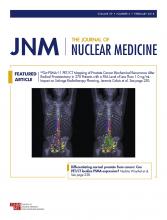REPLY: We thank Duncan et al. (1) for their interest in and response to our article (2). However, they charge that we misunderstand the consequences of radiation-induced DNA double-strand breaks (DSBs) based on our neglect of the fidelity of repair after such damage. We indeed omitted mention of the specific repair pathways and whether they are error-free; instead, we noted that misrepair, including residual mutations, does not entail increased cancer risk, and we provided evidence that low-dose medical imaging exposures do not contribute to future cancers, thereby ruling out DSBs as causal.
Duncan et al.’s narrow focus on mutations or any other “permanent information scars in the genome” misses the organism’s multilevel ability to compensate for such alterations. Since they fail to address the consequences of such scars on the health of the organism, they provide the reader with incomplete and misleading information. In noting that, of the 2 main pathways for DSB repair—nonhomologous end joining and homologous recombination—nonhomologous end joining is the more likely and more error-prone pathway, they potentially leave the reader with the false impression that such expected error-prone repair may lead to future cancer.
They neglect even to mention dose, dose rate, and linear energy transfer (LET) of the radiation exposure. Medical imaging involves low doses, low dose rates, and low-LET x-ray emissions and γ-emissions, and these greatly affect the fidelity of DSB repair (3–5). The repair accuracy depends on the number and spatial proximity of the breaks, which are, in turn, dependent on LET. Densely ionizing high-LET α-emissions produce multiple breaks in close proximity even at very low doses (3). In contrast, low-LET radiation at low doses and low dose rates decreases the DSB-misjoining frequency, resulting in more correctly rejoined ends. Although, for low-LET exposures, nonhomologous end joining may be error-prone at high dose rates, it is not measurably so at low dose rates, suggesting that the repair fidelity for medical imaging is no less than that by homologous recombination for endogenous DSBs (4).
Although Duncan et al. note that apoptosis may remove cells with unrepaired damage, they nevertheless suggest that some permanent mutations will remain after medical imaging. Even if some permanently mutated cells fail to commit cell suicide, Duncan et al. ignore the plethora of adaptive protections against cancer at the tissue and organismal levels—including antioxidant production, bystander signaling among damaged cells and their neighbors, and ultimately immune system cleanup of unrepaired cells—which act to protect the organism, preventing increased cancer rates (6,7).
These mechanisms defend the organism against both exogenous and endogenous DNA damage and enhance both survival and maintenance of genomic stability (which is critical for cancer avoidance). It is now recognized that cancer is not simply the end product of one or more mutations. Although mutations may be a necessary prequel, they are far from sufficient to produce clinical cancer, as we noted in our article (2). The 2015 Nobel Prize in Chemistry went to 3 investigators—Lindahl, Modrich, and Sancar—for discovering 3 intracellular repair mechanisms for preventing cancers that might otherwise develop. Modern understanding of the role of the immune system in the development of clinical cancers has led to a replacement of the outdated “one mutation = one cancer” model. Deficiencies in repair enzymes at the organismal level or evasion from immune system detection and destruction are the newest explanations for clinical cancer formation, rather than simply DNA damage or even residual mutations in the few damaged cells after inaccurate repair (8).
Duncan et al. conclude, “Until molecular biology uncovers a causal chain that refutes the linear no-threshold model and those findings are supported by epidemiologic studies, we believe that it is misguided and detrimental to children not to optimize radiation exposure during medical imaging.” This wrongly positions the demonstrably invalid linear no-threshold claim as the default paradigm, ignoring a mountain of evidence to the contrary. Doing so unjustifiably favors maneuvers designed to avoid a nonexistent low-dose risk. Inevitably, their emphatic advice only reinforces the known detrimental radiophobic effects of ALARA dosing and ignores the not-infrequent imaging-avoidance reactions of both patients and physicians (2,9).
Duncan et al. even contradict themselves by correctly acknowledging that the relationship between cancer causation and radiation exposure is linear only when doses of ionizing radiation exceed 100 mGy—a dose level much higher than those encountered in medical imaging. But they fail to acknowledge that below this dose both the linearity and the no-threshold aspects of the model have never been demonstrated but, instead, have been soundly refuted (10).
In summary, medical imaging is wrongly said to impose iatrogenic cancer risk due to radiation exposure. Credible evidence of imaging-related low-dose (<100 mGy) carcinogenic risk is nonexistent. It is high time that medical imaging professionals and radiation scientists all realize and acknowledge that, whereas damage may be linearly related to dose, the net effect of the multilevel, adaptive responses of the organism is necessarily nonlinear, as well as protective in the low-LET, low-dose, low-dose-rate realm of diagnostic medical imaging.
Footnotes
Published online Jan. 4, 2018.
- © 2018 by the Society of Nuclear Medicine and Molecular Imaging.







